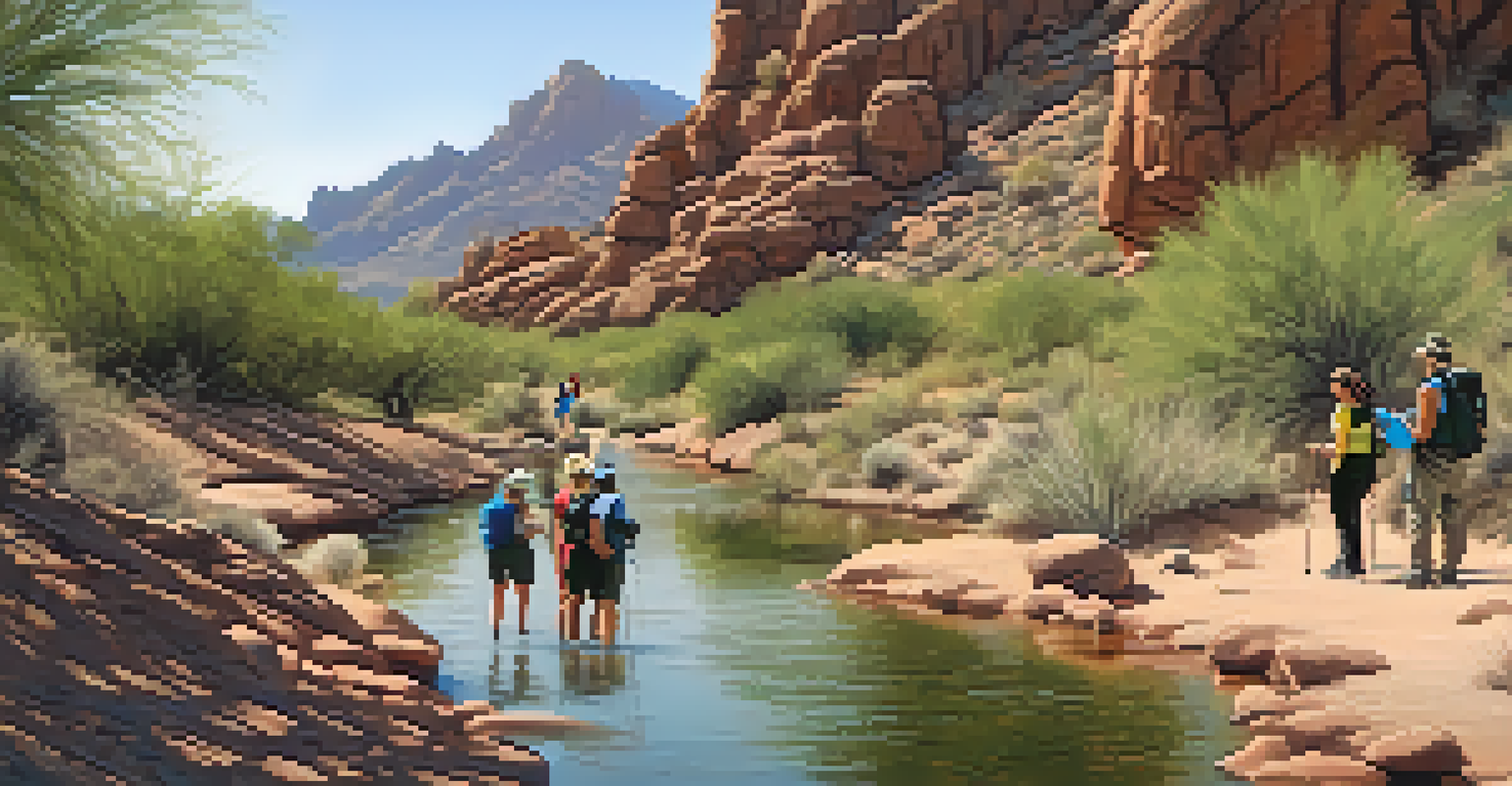Staying Hydrated: Essential for Hiking Safety in Scottsdale

Understanding the Arizona Climate and Its Impact
Scottsdale boasts a beautiful desert landscape, but this beauty comes with challenges, particularly when it comes to hydration. The dry, arid climate can lead to rapid fluid loss, making it vital for hikers to understand how the local weather affects their bodies. Temperatures can soar during the day, especially in summer, and the lack of humidity can make you unaware of how much water you're losing.
Water is the source of life, and without it, we cannot survive.
When hiking in these conditions, it’s easy to overlook the need for hydration until it’s too late. Many hikers underestimate how quickly they can become dehydrated, leading to fatigue, dizziness, or even more severe health issues. Making a conscious effort to stay hydrated is not just a good practice; it’s essential to ensure your safety on the trails.
So, before embarking on your hiking adventure, take a moment to familiarize yourself with the climate. Knowing what to expect can help you prepare accordingly, ensuring that you have enough water to tackle the beautiful but demanding trails of Scottsdale.
Signs of Dehydration to Watch Out For
Recognizing the signs of dehydration is crucial for every hiker. Symptoms can range from mild to severe, and they often start with feelings of thirst and dry mouth. As dehydration progresses, you might experience fatigue, headaches, and even dizziness, which can significantly hinder your hiking experience.

In more severe cases, dehydration can lead to confusion, increased heart rate, or even fainting. Knowing these symptoms can empower you to take action before they escalate. It’s important to listen to your body and not push through discomfort, as this can lead to serious health risks.
Hydration is Crucial for Hikers
Understanding the climate and staying hydrated is essential for enjoying the challenging trails of Scottsdale.
Keeping an eye on your hydration levels can be a game-changer during your hike. Make a habit of checking in with yourself regularly, and don’t hesitate to take a break and hydrate if you feel any signs of dehydration creeping in.
How Much Water Should You Bring?
A common question among hikers is, 'How much water should I bring?' A good rule of thumb is to drink about half a liter of water per hour of moderate activity in moderate temperatures. However, this can vary based on the intensity of your hike and the heat of the day, so adjust accordingly.
In every walk with nature one receives far more than he seeks.
For longer hikes, consider carrying more water than you think you'll need. It’s better to have extra water than to find yourself in a situation where you’re running low. Some hikers even prefer to take a hydration pack, which allows for easy sipping without having to stop and pull out a water bottle.
Ultimately, the amount of water you carry should be based on the length of your hike, the temperature, and your personal hydration needs. Always err on the side of caution and stay prepared!
Effective Hydration Strategies While Hiking
Hydration doesn’t start when you hit the trail; it begins before you even lace up your boots. Start hydrating the day before your hike by drinking plenty of water to ensure your body is well-prepared. This pre-hydration can help you maintain your energy levels and stay alert during your hike.
During the hike, set reminders to drink water at regular intervals. Many hikers find that sipping small amounts frequently is more effective than chugging down a large bottle all at once. You might even carry a small, portable water bottle that’s easy to access, making it more convenient to drink as you walk.
Recognize Dehydration Symptoms
Being aware of the signs of dehydration empowers hikers to take preventative action and ensure their safety.
Additionally, consider incorporating electrolyte-rich drinks if you’re hiking for an extended period or in especially hot conditions. These drinks can help replace the minerals lost through sweat and keep you feeling your best.
The Role of Snacks in Staying Hydrated
Did you know that what you eat can affect your hydration levels? Foods with high water content, like fruits and vegetables, can provide additional hydration while you're on the trail. Snacks such as watermelon, oranges, or cucumber slices can be refreshing and help keep your hydration levels up.
In addition to high-water snacks, you'll want to include energy-dense foods that provide carbohydrates and electrolytes, which can aid in hydration and energy levels. Trail mixes that include nuts, seeds, and dried fruits can be a perfect pick, offering both nutrition and hydration support.
So next time you pack for a hike, think beyond just water and consider including hydrating snacks. The right combination can make a significant difference in your overall hydration and energy levels.
Planning Your Route and Water Sources
Before heading out, it's essential to plan your hiking route and identify potential water sources along the way. Some trails may have streams or springs where you can refill your water supply, while others may require you to carry all your water. Researching your route in advance can help you gauge how much water you'll need.
Utilizing resources like trail maps or apps that provide information on water sources can be invaluable. Knowing where you can stop to refill can ease your mind and allow you to enjoy the hike without the constant worry of running out of water.
Plan for Water Sources on Trails
Researching your hiking route and identifying water sources can help manage hydration needs effectively.
Also, remember that even if you find a water source, it's crucial to filter or purify the water before drinking. Carrying a portable water filter or purification tablets can ensure that you stay safe while staying hydrated.
Staying Hydrated During Group Hikes
When hiking in a group, hydration becomes a shared responsibility. It’s essential to encourage each other to drink water regularly and check in on one another’s hydration status. Group hikes are a fantastic opportunity to look out for each other, and reminding friends to hydrate can enhance everyone’s experience.
Consider designating a 'hydration break' during your hike, where everyone takes a moment to drink water and refuel with snacks. This not only promotes hydration but also fosters camaraderie and connection among group members, making your hike more enjoyable.

Additionally, share tips on hydration strategies within the group. Everyone has different preferences and experiences, so swapping stories can lead to better hydration habits for all involved.
Conclusion: Prioritize Hydration for Safe Hiking
In conclusion, staying hydrated is a vital aspect of hiking safety, particularly in the beautiful but challenging environment of Scottsdale. By understanding the climate, recognizing the signs of dehydration, and planning appropriately, you can ensure a safe and enjoyable hiking experience.
Remember to pack enough water, incorporate hydrating snacks, and plan your routes carefully. Encourage group members to prioritize hydration, and don’t hesitate to take breaks when needed. The trails are waiting, and staying hydrated will help you fully enjoy the adventure.
So, as you prepare for your next hike, keep hydration at the forefront of your mind. With proper planning and awareness, you’ll not only stay safe but also have a fantastic time exploring the stunning landscapes of Scottsdale.